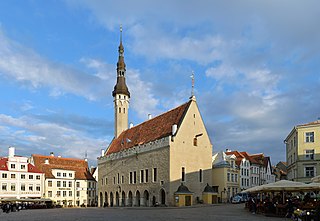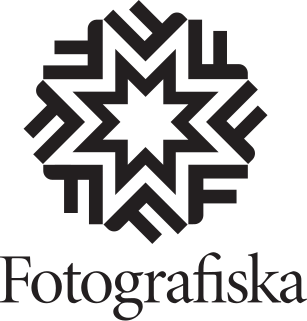
Tallinn is the most populous, primate, and capital city of Estonia. Situated on a bay in north Estonia, on the shore of the Gulf of Finland of the Baltic Sea, Tallinn has a population of 437,811 and administratively lies in the Harju maakond (county). Tallinn is the main financial, industrial, and cultural centre of Estonia. It is located 187 km (116 mi) northwest of the country's second largest city Tartu, however only 80 km (50 mi) south of Helsinki, Finland, also 320 km (200 mi) west of Saint Petersburg, Russia, 300 km (190 mi) north of Riga, Latvia, and 380 km (240 mi) east of Stockholm, Sweden. From the 13th century until the first half of the 20th century, Tallinn was known in most of the world by variants of its other historical name Reval.

Tallinn Airport or Lennart Meri Tallinn Airport is the largest airport in Estonia, which serves as a hub for the national airline Nordica, as well as the secondary hub for AirBaltic, cargo airline Airest and LOT Polish Airlines. It was also the home base of the now defunct national airline Estonian Air. Tallinn Airport is open to both domestic and international flights. It is located 2.7 nautical miles southeast of the centre of Tallinn on the eastern shore of Lake Ülemiste. It was formerly known as Ülemiste Airport.

Lake Ülemiste is the largest of the lakes surrounding Tallinn, Estonia. Ülemiste is the main part of the Tallinn water supply system, which supplies the city with most of its drinking water. The lake is fed mostly by Kurna stream and the Pirita River, through the Vaskjala–Ülemiste canal.

Tallinna Linnatranspordi AS (TLT) is a transportation company owned by the city of Tallinn, Estonia. TLT is a result of the merger of Tallinn Bus Company and Tallinn Tram and Trolleybus Company in July 2012. The company provides bus, trolleybus, and tram services in Tallinn.
Tallinn University is a public research university in Estonia. Located in the centre of Tallinn, the capital city of Estonia, Tallinn University is one of the three largest institutions of higher education in the country. Both QS World University and Times Higher Education rankings place it among the top 1000 universities in the world.

Mustamäe is one of the 8 administrative districts of Tallinn, the capital of Estonia. The smallest by area, it is at the same time the second largest district by population with 66,305 inhabitants . It is located 5 km from the centre of Tallinn and is bordered by districts Haabersti, Nõmme, and Kristiine. Local housing is mostly represented by 5–9 storeys high panel blocks of flats, built in the 1960–1970s.

Linnahall is a multi-purpose venue in Tallinn, Estonia. It is situated in the harbor, just beyond the walls of the Old Town, and was completed in 1980. The venue also features a heliport and a small seaport.

Kiek in de Kök is an artillery tower in Tallinn, Estonia, built in 1475. It gained the name Kiek in de Kök from the ability of tower occupants to see into kitchens of nearby houses. The tower is 38 m high and has walls 4 m thick. Cannon balls dating back to 1577 are still embedded in its outer walls.
Tallinnfilm is the oldest surviving film studio in Estonia. It was founded as Estonian Culture Film in 1931, and was nationalized in 1940 after Estonia was forced into the Soviet Union. During the first year of Soviet Occupation (1940–1941) Eesti Kultuurfilm was taken over by the Communist Party and renamed Kinokroonika Eesti Stuudio. In 1942 during the German occupation the studio was renamed Kinokroonika Tallinna Stuudio and then renamed again as Tallinna Kinostuudio in 1947 by the Soviets. The Tallinn Film Studio was renamed Kunstiliste ja Kroonikafilmide Tallinna Kinostuudio in 1954 and in 1963 was renamed again Tallinnfilm.

The Tallinn Town Hall is a building in the Vanalinn of Tallinn (Reval), Estonia, next to the Town Hall Square. The building is located in the south side of the medieval market square and is 36.8 metres (121 ft) long. The west wall is 14.5 metres (48 ft) in length, and the east is 15.2 metres (50 ft). It is a two-storey building with a spacious basement. It is the oldest town hall in the whole Baltic Sea region and Scandinavia.

Fotografiska is a centre for contemporary photography in the Södermalm district of Stockholm, Sweden that was founded by brothers Jan and Per Broman and opened on 21 May 2010. In March 2021, it merged with NeueHouse and is operated by Yoram Roth and Josh Wyatt under the parent company CultureWorks.

Estonian Maritime Academy of Tallinn University of Technology is a vocational university in Estonia. It is one of the schools of Tallinn University of Technology and it is the only educational institution in Estonia that offers professional higher education and Master’s level education in the maritime field. The university is located in the capital Tallinn but also has two centres in Saaremaa. In addition to higher education, the school contributes to research, provides training and offers services. The Academy also holds a one of a kind Simulator Centre and has a whole dedicated floor of hi-tech laboratories.

Google Arts & Culture is an online platform of high-resolution images and videos of artworks and cultural artifacts from partner cultural organizations throughout the world.

The Tallinn Power Plant is a former power plant located in Tallinn, Estonia. Construction of the power plant was initiated by Volta company and it was decided by the Tallinn City Council in 1912 after the work of special committee established in 1909. The plant was located next to the Tallinn Gas Factory at the location of the former Stuart fortress. The plant was designed by Volta and the architect was Hans Schmidt. Originally it used three Laval-type 250 horsepower (0.19 MW) steam turbines and three 250 horsepower (0.19 MW) electric generators—all produced by Volta. Two coal-fired boilers were manufactured by AS Franz Krull. The power plant was opened on 24 March 1913, and originally it was fired by coal. In 1919–1920 the plant was expanded and transferred to peat and wood. In 1924 the power plant was switched to oil shale. It was the first power plant in the world to employ oil shale as its primary fuel. In 1939, the plant achieved capacity of 22 MW.
The following is a timeline of the history of the city of Tallinn, Estonia.

The Tallinn tram network is the only tram network in Estonia. Together with the four-route trolleybus network (et), the four tram lines, with a total length of 19.7 km arranged in a roughly cross-shaped layout, provide a backbone for the public transport network in the Estonian capital. All the routes meet up at Hobujaama in the city centre. Trams are unidirectional, one-sided and single-person operated, and much of the network runs on segregated track.

Tallinn Legends - is a tourist attraction in a form of theatrical and interactive museum in Tallinn, Estonia. The museum recreates historical events and legends that have contributed to the folklore of medieval Tallinn . It uses a mixture of storytelling, live performances and special effects.

Chocolala Chocolate Museum is a specialty museum dedicated to the history of the Estonian chocolate industry. It is located in the Tallinn Old Town district near Freedom Square, Tallinn, Estonia.
The 2020 Estonian Football Winter Tournament or the 2020 EJL Jalgpallihalli Turniir is the fifth edition of the annual tournament in Estonia. This tournament is divided into 5 groups of 7 teams.

Church of St. John's almshouse is a wooden church in Tallinn, Estonia. Since 1999 the building is designated as "architectural monument".


















